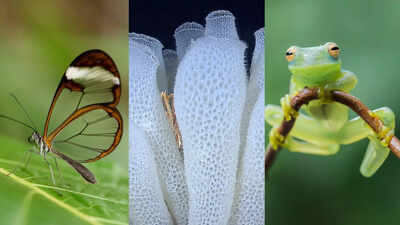ARTICLE AD BOX

In the diverse world of nature, some extraordinary creatures have developed transparent or translucent bodies, allowing them to blend seamlessly into their surroundings. This unique adaptation serves as a highly effective survival strategy, making these animals almost invisible to predators and, in some cases, to their prey.
Transparency can be found in both aquatic and terrestrial species, each benefiting from reduced visibility in its environment. From delicate insects to deep-sea dwellers, these animals demonstrate the remarkable creativity of evolution, showcasing nature’s ability to equip organisms with ingenious methods for protection, camouflage, and survival.
List of animals with glass-like bodies
1. Glasswing Butterfly (Greta oto)

Native to Central and South America, the Glasswing Butterfly is renowned for its transparent wings, which lack scales and allow light to pass through.
This transparency enables the butterfly to blend seamlessly into its surroundings, making it challenging for predators to detect. Despite their delicate appearance, Glasswing Butterflies are strong fliers and undertake long migrations across vast distances.2. Glass Frog (Centrolenidae family)

Glass Frogs, found in the rainforests of Central and South America, are notable for their translucent abdominal skin, which reveals their internal organs.
This transparency is believed to aid in camouflage, as their underside closely resembles the reflective surfaces of water droplets. The species Hyalinobatrachium dianae, discovered in Costa Rica, showcases a bright green dorsal side and a clear ventral side, allowing researchers to observe its heart, liver, and digestive system through its skin.3. Barreleye Fish (Macrourida family)

Source: MBARI
The Barreleye Fish, inhabiting the deep ocean waters, possesses a transparent head with a dome-shaped, see-through skull.
This unique feature allows it to look upward to detect prey while remaining hidden from predators below. Its transparent body and specialised adaptations make it a fascinating subject of study in marine biology.4. Glass Octopus (Vitrellella richardi)

Source: BBC
The Glass Octopus is a rare and elusive deep-sea creature with a transparent body, making it nearly invisible in its natural habitat. Its transparency aids in evading predators and is a subject of interest for researchers studying deep-sea organisms.5. Ghost Catfish (Kryptopterus vitreolus)

Native to Southeast Asia, the Ghost Catfish is an aquarium fish known for its nearly transparent body. Its skin allows approximately 90% of light to pass through, and its muscles contain microscopic structures that bend light to produce shimmering rainbow colours. This bioluminescence is thought to play a role in communication and mating displays.6. Tortoise Beetle (Cassidinae subfamily)

The Tortoise Beetle, found in various parts of the world, has a unique transparent shell that serves as both protection and camouflage.
When threatened, it can retract its legs and head beneath its transparent shield, resembling a droplet of water or a piece of dew-covered foliage, thereby deterring potential predators.7. Pharaoh Ant (Monomorium pharaonis)

Pharaoh Ants are small, nearly transparent ants that have adapted to living in human-made environments. Their transparency and small size make them elusive and challenging to control, allowing them to thrive in various habitats, including hospitals and homes.8. Sea Salp (Salpa genus)

Sea Salps are barrel-shaped, transparent marine animals that drift in the ocean's currents. They form long chains and filter plankton from the water, playing a significant role in marine ecosystems by contributing to the ocean's carbon cycle.9. Venus' Flower Basket (Euplectella aspergillum)

Found in the deep ocean, the Venus' Flower Basket is a glass-like sponge that forms intricate, transparent structures resembling baskets. These sponges are composed of silica and house pairs of shrimp, which live symbiotically within their transparent skeletons.10. European Eel Larvae (Anguilla anguilla)

The larvae of the European Eel are transparent and leaf-shaped, drifting across the Atlantic Ocean from the Sargasso Sea to Europe. Their transparency during this early life stage helps them avoid predators as they make their long journey to freshwater rivers.Also read | Madagascar’s elephant bird: Discover about the 450 kilogram giant flightless bird



.png)
.png)
.png)
















 3 hours ago
3
3 hours ago
3









 English (US) ·
English (US) ·